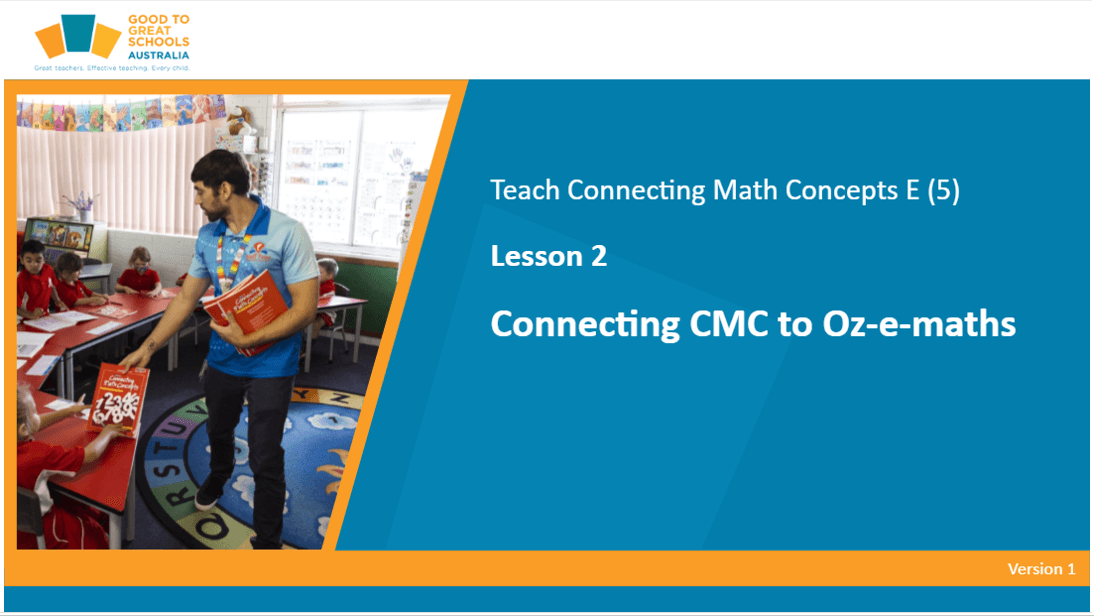Oz-e-maths Supplementary Materials for Connecting Maths Concepts
Top-ups and Swap-outs for Currency and Measurement
Year F – Year 5
Oz-e-maths Supplementary Materials for Connecting Maths Concepts units align to the Australian Curriculum Content Descriptions for mathematics.
Share this page:
Starter Lessons
Year Overview
Foundation Year
Year F, Lesson 1
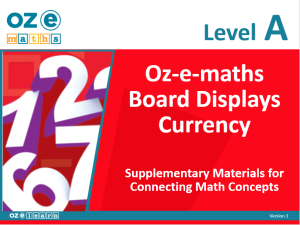
Teaching Resources
Australian Curriculum Content Descriptions
Overview
Top-ups and Swap-outs for Currency and Measurement – Foundation Year is a Mathematics unit for Foundation Year students. It works in cooperation with Connecting Maths Concepts (CMC) Level A to ensure that delivery of CMC aligns with Australian Curriculum gap requirements.
It aligns to the Australian Curriculum:
- Represent practical situations involving addition, subtraction and quantification with physical and virtual materials and use counting or subitising strategies (AC9MFN05).
- Identify and compare attributes of objects and events, including length, capacity, mass and duration, using direct comparisons and communicating reasoning (AC9MFM01).
- Sequence days of the week and times of the day including morning, lunchtime, afternoon and night time, and connect them to familiar events and actions (AC9MFM02).
Learning Objectives
In Lesson 1 (CMC Level A: Lessons 11–20), students learn to:
- say the number and days of the week
- say the days of the week
- say and order the days of the week
- identify today, yesterday and tomorrow
- identify weekday and weekend
- connect days of the week to familiar events
- sequence familiar events in time order
- make connections with everyday events
- use first, next or last to order events.
In the Swap-Outs, students learn to:
- identify and count Australian notes and coins
- measure attributes including height, weight and length.
Success Criteria
- Say and order the days of the week.
- Identify weekdays and weekends.
- Connect days of the week to familiar events.
- Connect everyday events.
- Use first, next or last to order events.
- Recognise the notes and coins of Australian Currency.
- Compare and order lengths of objects.
Assessment
Mastery Tests
- Mastery Tests are given at the end of every 10 lessons, designed to be taught over a two-week cycle. Mastery Tests allow teachers to monitor student understanding of the concepts taught in previous lessons and to identify where reteaching is needed.
- The Teaching Guide contains the Mastery Test script. Mastery Tests are delivered using a presentation script, board displays and a handout for students. The Teaching Guide also contains the Answer Key.
Cumulative Tests
- There are two Cumulative Tests for Swap-Outs that are completed after lesson 60 and lesson 120. The Cumulative Tests are in the Teaching Guide.
- Teachers copy the assessment and distribute to students at testing time.
Year 1
Year 1, Lesson 1
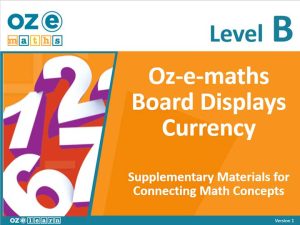
Teaching Resources
Australian Curriculum Content Descriptions
Overview
Top-ups and Swap-outs for Currency and Measurement – Year 1 is a Mathematics unit for Year 1 students. It works in cooperation with Connecting Maths Concepts (CMC) to ensure that delivery of CMC aligns with Australian Curriculum gap requirements:
- Recognise, describe and order Australian coins according to their value (ACMNA017).
- Identify outcomes of familiar events involving chance and describe them using everyday language such as ‘will happen’, ‘won’t happen’ or ‘might happen’ (ACMSP024).
- Measure and compare the lengths and capacities of pairs of objects using uniform informal units (ACMMG019).
- Tell time to the half-hour (ACMMG020).
- Describe duration using months, weeks, days and hours (ACMMG021).
- Use mathematical modelling to solve practical problems involving additive situations, including simple money transactions; represent the situations with diagrams, physical and virtual materials, and use calculation strategies to solve the problem (AC9M1N05).
Learning Objectives
- Identify chance of familiar events.
- Justify chance of familiar events.
- Identify possible/impossible events.
- Identify certain and possible events.
In the Swap-Outs, students learn to:
- identify and count Australian coins and notes
- apply ruler skills to measure length
- use a ruler to count backwards
- solve comparison word problems.
Success Criteria
- Identify outcomes of familiar events involving chance.
- Describe everyday events using language such as ‘will happen’, ‘won’t happen’, or ‘might happen’.
- Use a ruler to count backwards.
- Demonstrate simple money transactions.
Assessment
Mastery Tests
- Mastery Tests are given at the end of every 10 lessons, designed to be taught over a two-week cycle. Mastery Tests allow teachers to monitor student understanding of the concepts taught in previous lessons and identify where reteaching is needed.
- The Teaching Guide contains the Mastery Test script. Mastery Tests are delivered using a presentation script, board displays and a handout for students. The Teaching Guide also contains the Answer Key.
Cumulative Tests
- There are two Cumulative Tests for Swap-Outs that are completed after lesson 60 and lesson 120.
- Teachers copy the assessment and distribute to students at testing time.
Year 2
Year 2, Lesson 1
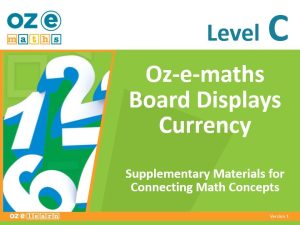
Teaching Resources
Australian Curriculum Content Descriptions
Overview
Top-ups and Swap-outs for Currency and Measurement – Year 2 is a Mathematics unit for Year 2 students. It works in cooperation with Connecting Maths Concepts (CMC) to ensure that delivery of CMC aligns with Australian Curriculum gap requirements. It aligns to the Australian Curriculum:
- Measure the length of shapes and objects using informal units, recognising that units need to be uniform and used end-to-end (AC9M1M02).
- Describe the duration and sequence of events using years, months, weeks, days and hours (AC9M1M03).
- Group, partition and rearrange collections up to 1000 in hundreds, tens and ones to facilitate more efficient counting (ACMNA028).
- Group, partition, rearrange and rename numbers up to 1,000 according to their place value and into other number groupings (AC9M2N02).
- Recognise and explain the connection between addition and subtraction as inverse operations, apply to partition numbers and find unknown (AC9M2A01).
- Count and order small collections of Australian coins and notes according to their value (ACMNA034).
Learning Objectives
In Lesson 3 (CMC Level C: Lesson 31–40), students learn to:
- know that two-digit numbers are comprised of tens and ones
- use pictorial MABs to demonstrate that three-digit numbers are comprised of hundreds, tens, and ones/units
- show that three-digit numbers are comprised of hundreds, tens, and ones/units
- demonstrate three-digit numbers are comprised of hundreds, tens, and ones/units.
In Lesson 4 (CMC Level C: Lesson 51–60), students learn to:
- describe skip counting and the pattern of counting by 2s
- use counting by 2s to count a collection of objects
- represent skip counting by 2s on a number line, identifying the missing number
- describe the 2s skip counting pattern beyond 100
- describe the pattern of skip counting by 5s
- use skip counting by 5s to represent the pattern
- use skip counting by 10s to represent the pattern and identify the missing number.
In lesson 5 (CMC Level C: Lessons 91–100), students learn to:
- describe the effect of a one-step slide
- identify a one-step slide
- describe the effect of a flip
- identify a flip or slide
- investigate the effect of flips by moving and drawing shapes
- demonstrate the effect of slides and flips by drawing irregular shapes.
In Lesson 6 (CMC Level C: Lesson 101–110), students learn to:
- identify and describe half and quarter turns
- demonstrate a half turn and quarter turn to create a pattern.
In the Swap-Outs, students learn to:
- identify and count Australian coins
- apply ruler skills to measure length
- use a ruler to count backwards
- to solve comparison word problems.
Success Criteria
Top-Ups
- Identify and describe flip and slide.
- Identify and describe half and quarter turns to create a pattern.
- Use skip counting by 2s, 5s and 10s to count a collection of objects and create patterns.
- Understand two-digit and three-digit numbers place value.
Swap-Outs
- Identify and count Australian coins.
- Apply ruler skills to measure length and count backwards.
- Solve comparison word problems.
Assessment
Mastery Tests
- Mastery Tests are given at the end of every 10 lessons, designed to be taught over a two-week cycle. Mastery Tests allow teachers to monitor student understanding of the concepts taught in previous lessons and identify where reteaching is needed.
- The Teaching Guide contains the Mastery Test script. Mastery Tests are delivered using a presentation script, board displays and a handout for students. The Teaching Guide also contains the Answer Key.
Cumulative Tests
- There are two Cumulative Tests for Swap-Outs that are completed after lesson 60 and lesson 120. The Cumulative Tests are in the Teaching Guide.
- Teachers copy the assessment and distribute to students at testing time.
Year 3
Year 3, Lesson 1
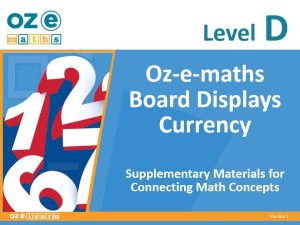
Teaching Resources
Australian Curriculum Content Descriptions
Top-ups and Swap-outs for Currency and Measurement – Year 3 is a Mathematics unit for Year 3 students. It works in cooperation with Connecting Maths Concepts (CMC) to ensure that delivery of CMC aligns with Australian Curriculum gap requirements. It aligns to the Australian Curriculum:
- Use combinations of shapes and objects to make or approximate more complex shapes and objects in the environment (AC9M3SP01).
- Analyse the effectiveness of different displays or visualisations in illustrating and comparing data distributions, then discuss the shape of (AC9M3ST02).
- Represent money values in multiple ways and count the change required for simple transactions to the nearest five cents
- (ACMNA059).
Measure, order and compare objects using familiar metric units of length, mass - and capacity (ACMMG061).
Tell time to the minute and investigate the relationship between units of time (ACMMG062).
Learning Objectives
- Define the terms: pyramid, polygon and net, and describe the process of using nets to construct three-dimensional shapes.
- Construct a triangular-based pyramid (tetrahedron).
- Define the term: prism and identify the net of a prism.
- Match 3D shapes to their net.
- Interpret picture graphs, bar graphs and line graphs.
- Compare data displayed as picture graphs, bar graphs and line graphs.
- Define symmetry and identify symmetry in the environment.
- Draw single and multiple lines of symmetry Identify symmetry in cave art and 2D shapes.
Success Criteria
- Define the terms: pyramid, polygon and net, and describe the process of using nets to construct three-dimensional shapes.
- Construct a triangular-based pyramid (tetrahedron).
- Define the term: prism and identify the net of a prism.
- Match 3D shapes to their net.
- Interpret picture graphs, bar graphs and line graphs.
- Compare data displayed as picture graphs, bar graphs and line graphs.
- Define symmetry and identify symmetry in the environment.
- Draw single and multiple lines of symmetry.
- Identify symmetry in cave art and 2D shapes.
Assessment
Mastery Tests
- Mastery Tests are given at the end of every 10 lessons, designed to be taught over a two-week cycle. Mastery Tests allow teachers to monitor student understanding of the concepts taught in previous lessons and identify where reteaching is needed.
- The Teaching Guide contains the Mastery Test script. Mastery Tests are delivered using a presentation script, board displays and a handout for students. The Teaching Guide also contains the Answer Key.
Cumulative Tests
- There are two Cumulative Tests for Swap-Outs that are completed after lesson 60 and lesson 120. The Cumulative Tests are in the Teaching Guide.
- Teachers copy the assessment and distribute to students at testing time.
Year 4
Year 4, Lesson 1
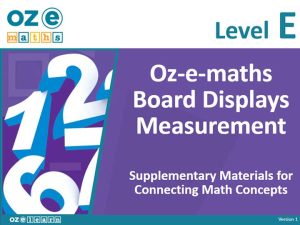
Teaching Resources
Australian Curriculum Content Descriptions
Overview
Top-ups and Swap-outs for Currency and Measurement – Year 4 is a Mathematics unit for Year 4 students. It works in cooperation with Connecting Maths Concepts (CMC) to ensure that delivery of CMC aligns with Australian Curriculum gap requirements. It aligns to the Australian Curriculum:
- Express natural numbers as products of their factors, recognise multiples and determine if one number is divisible by another (AC9M4N02).
- Plan and conduct statistical investigations by posing investigative questions or identifying a problem and collecting data relevant to it (AC9M4ST03).
- Acquire, validate and represent data for nominal and ordinal, categorical and discrete numerical variables, to address (AC9M4ST01).
- Interpret line graphs representing change over time; discuss the relationships that are represented and conclusions that can be made (AC9M4ST02).
- Describe and perform translations, reflections and rotations of shapes, using dynamic geometric software where appropriate (AC9M4SP03).
- Construct a grid coordinate system that uses coordinates to locate positions within a space (AC9M4SP02).
- List the possible outcomes of chance experiments involving equally likely outcomes and compare to those which are not equally likely (AC9M4P01).
- Conduct repeated chance experiments to observe relationships between outcomes; identify and describe the variation in results (AC9M4P02).
- Solve problems involving purchases and the calculation of change to the nearest five cents with and without digital technologies (ACMNA080).
Learning Objectives
In Lesson 10 (CMC Level E: Lesson 11–20), students learn to:
- define area
- identify regular shapes and calculate the area by counting the square centimetres
- write the area unit of measurement (cm2) for regular shapes
- identify irregular shapes and calculate the area by counting the square centimetres
- write the area unit of measurement (cm2) for irregular shapes.
In Lesson 11 (CMC Level E: Lesson 21–30), students learn to:
- identify odd and even numbers
- add with odd and even numbers
- subtract with odd and even numbers
- divide with odd and even numbers.
In Lesson 12 (CMC Level E: Lesson 31–40), students learn to:
- define data, identifying different methods for displaying data (table and frequency table) and how to interpret the data (tally marks)
- identify how a survey can be used to collect data and represented using a frequency table
- use tally marks to record and interpret data in a frequency table
- use a frequency table to record data collected from observation and surveys.
In Lesson 13 (CMC Level E: Lesson 41–50), students learn to:
- identify features of a picture graph
- construct a simple picture graph
- interpret a picture graph (picture represents frequency more than 1)
- construct a many-to-one picture graph
- identify features of a column graph
- identify features of the vertical (y) axis
- identify features of the horizontal (x) axis and compare graphs
- label the features and construct a column graph from given data.
In Lesson 14 (CMC Level E: Lesson 51–60), students learn to:
- define data and how it can be displayed
- identify one-to-one correspondence in picture graphs
- identify many-to-one correspondence in picture graphs
- compare One-to-One and Many-to-One correspondence in picture graphs
- pose questions that can be answered by the data results
- compare different types of data displays with the same data represented in each
- compare different types of data displays and evaluate the effectiveness of each.
In Lesson 15 (CMC Level E: Lesson 61–70), students learn to:
- describe symmetry and examine symmetry in 2D shapes
- identify and draw lines of symmetry
- draw symmetrical shapes
- identify shapes with complex symmetry.
In Lesson 16 (CMC Level E: Lessons 91–100), students learn to:
- describe direction using the main points on a compass
- describe direction using the minor points on a compass
- describe direction of places on a map using points on a compass
- identify the compass points and use direction to describe and interpret information on a map
- use a legend to interpret information on a map
- construct a legend from the information contained in a map
- define and use scale to interpret distance on a map
- use scale to interpret approximate distances on a map
- construct a legend from information contained in a map, including a compass and scale.
In Lesson 17 (CMC Level E: Lessons 101–110), students learn to:
- define: certain, likely, unlikely and impossible and use these terms to describe the probability of events
- select either certain or impossible to describe the probability of an event
- select either likely or unlikely to describe the probability of an event
- order the probability of events from impossible to certain
- describe the probability of an event occurring as more likely, less likely or equally likely
- order the probability of events from least likely to most likely.
In Lesson 18 (CMC Level E: Lessons 111–120), students learn to:
- define chance and apply the language of chance
- apply the language of chance to order from least to most likely
- apply the language of chance to order from least to most likely
- order from most likely, least likely and equal chance to occur
- define dependent events
- identify events that cannot happen at the same time
- define and label the timing of dependent events
- define and label when a dependent event affects another event
- identify when an event is dependent or not dependent.
In Lesson 19 (CMC Level E: Lessons 121–130), students learn to:
- identify independent events that can happen at the same time
- identify when an event is independent or dependent
- identify how independent events do not affect the next event
- demonstrate understanding of the timing and effect of dependent and independent events.
Success Criteria
Top-Ups
- Calculate the area of regular and irregular shapes.
- Identify, add, subtract and divide odd and even numbers.
- Create tables and use tally marks for data collection and displays.
- Construct and label picture graphs and column graphs.
- Understand symmetry.
- Understand chance and probability of dependent and independent events.
Swap-Outs
- Apply arithmetic skills for all units of measurement.
- Solve comparison word problems.
Assessment
Mastery Tests
- Mastery Tests are given at the end of every 10 lessons, designed to be taught over a two-week cycle. Mastery Tests allow teachers to monitor student understanding of the concepts taught in previous lessons and identify where reteaching is needed.
- The Teaching Guide contains the Mastery Test script. Mastery Tests are delivered using a presentation script, board displays and a handout for students. The Teaching Guide also contains the Answer Key.
Cumulative Tests
- There are two Cumulative Tests for Swap-Outs that are completed after lesson 60 and lesson 120. The Cumulative Tests are in the Teaching Guide.
- Teachers copy the assessment and distribute to students at testing time.
Year 5
Year 5, Lesson 1
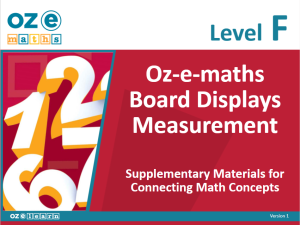
Teaching Resources
Australian Curriculum Content Descriptions
Overview
Top-ups and Swap-outs for Currency and Measurement – Year 5 is a Mathematics unit for Year 5 students. It works in cooperation with Connecting Maths Concepts (CMC) to ensure that delivery of CMC aligns with Australian Curriculum gap requirements. It aligns to the Australian Curriculum:
- Select and use appropriate displays or visualisations, interpret and communicate findings or solutions within the context (AC9M5ST03).
- Justify choices and explain results in terms of the situation (AC9M5N09).
- Use observation and experience to assign probabilities that events occur in a given context, using fractions, percentages and decimals to indicate their estimated likelihood (AC9M6P01).
- Recognise and describe what changes and what remains the same under the transformation and identify any rotational symmetries (AC9M5SP03).
- Create simple financial plans (ACMNA106).
Learning Objectives
In Lesson 20 (CMC Level F: Lesson 31–40), students learn to:
- use the grid reference system to describe location
- apply directional language using the compass points (North, East, South and West)
- use a legend to identify landmarks on a map
- construct a legend from the information contained in a map, including a compass.
In lesson 21 (CMC Level F: Lessons 41–50), students learn to:
- define data and how it can be displayed
- read a frequency table
- examine data question types
- identify and use open questions and closed questions
- identify categorical and numerical data types
- collect categorical data and conduct a survey.
In Lesson 23 (CMC Level F: Lesson 61–70), students learn to:
- calculate a tuckshop order
- define and calculate a budget
- create a budget for a class fundraising event
- define and identify GST on items.
In Lesson 25 (CMC Level F: Lesson 81–90), students learn to:
- define probability – certain, likely, even chance, unlikely and impossible – and use these terms to describe the probability of an event occurring
- recognise that probabilities can be expressed as a fraction from 0 to 1.
In Lesson 28 (CMC Level F: Lesson 111–120), students learn to:
- define and identify the rotational symmetry of two-dimensional shapes
- identify the points of rotational symmetry
- identify rotational symmetry in patterns
- identify reflection symmetry using the x or y axis to complete the shape
- identify line symmetry by drawing a reflection
- define translation and use this term to describe two-dimensional shapes
- describe the translations, reflections, or rotations of two-dimensional shapes
- use rotational symmetry to draw a two-dimensional shape
- define transformation and identify translations, reflections, and rotations
- use enlargement transformation to draw two-dimensional shapes.
Success Criteria
Top-Ups
- Apply directional language and understand the compass points.
- Collect and identify categorical and numerical data types.
- Understand budgeting.
- Define probability using language and fractions.
- Understand symmetry, transformations, translations, reflections or rotations of two-dimensional shapes.
Swap-Outs
- Apply arithmetic skills for all units of measurement.
- Solve comparison word problems.
Assessment
Mastery Tests
- Mastery Tests are given at the end of every 10 lessons, designed to be taught over a two-week cycle. Mastery Tests allow teachers to monitor student understanding of the concepts taught in previous lessons and identify where reteaching is needed.
- The Teaching Guide contains the Mastery Test script. Mastery Tests are delivered using a presentation script, board displays and a handout for students. The Teaching Guide also contains the Answer Key.
Cumulative Tests
- There are two Cumulative Tests for Swap-Outs that are completed after lesson 60 and lesson 120. The Cumulative Tests are in the Teaching Guide.
- Teachers copy the assessment and distribute to students at testing time.
Lesson Design
Lesson Objective
Success Criteria
Activating Prior Knowledge
I Do
We Do
Apple Question
You Do
Revise
Professional Learning
We have professional learning modules to assist schools in delivering Connecting Math Concepts (CMC). There is a module for each year level of CMC. Please ensure you are logged in to access these links:

